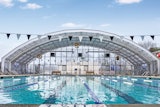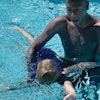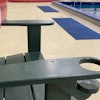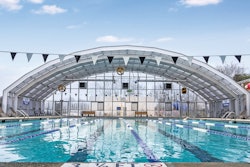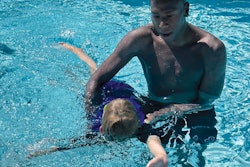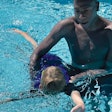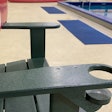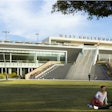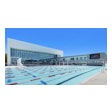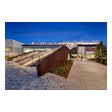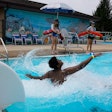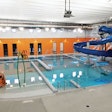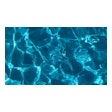Improving on the leisure pool concept.
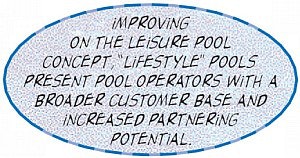
As the new millennium dawns, an exciting concept in aquatic facilities is emerging. Replacing 1980s-style leisure pools are "lifestyle" pools, which generate new opportunities for fitness and health, rehabilitation and therapy, and socialization. They are appealing to a largely untapped and potentially huge market.
By blending traditional swimming programs associated with the conventional "competitive" pool, the non-programmed fun of the leisure pool and the public's burgeoning interest in wellness, the lifestyle pool presents aquatic center operators with a broader customer base, new cross-marketing opportunities and increased partnering potential. Combined, these three developments offer fresh revenue streams, which can substantially enhance the financial viability of new and existing facilities.
Commencing in the 1970s in Europe, the leisure concept of aquatic center design was developed to increase pool usage, generate revenue and reduce or even eliminate operating deficits. More conventional competitive pools were designed to meet the program needs of a specific and fairly narrow user population - the competitive swimmer and diver, those enrolled in aquatic programs such as Learn to Swim, and fitness ("lap") swimmers.
By expanding the user base to include children and families, the usage rates of leisure-based aquatic centers increased substantially over their conventional cousins. By the early 1990s, the trend had left a trail of leisure mega-palaces involving not only leisure water, but leisure ice and dry-land complexes. These facilities were usually designed as natural light-starved "black boxes" with heavily themed or artificial interior environments. These could range from a South Seas setting to an Ice Age setting and practically everything in between; it would not be at all unusual to discover palm trees, electrically operated flying birds, giant dinosaurs and myriad other stimulating features in one of these facilities.
While use and excitement remained high during their initial years of operation, by the mid-'90s many of these large, expensive and operationally complex facilities were running into financial difficulty. The reason. They had become boring!
Many leisure-pool facilities are innovative and dynamic but, unfortunately, single-purpose complexes. To create excitement and interest, a leisure pool provides moving water, variations in water temperature and variations in water depth. Normal components in a leisure pool that address these demands include wave machines, water slides, water features such as spray units and bubblers, tarzan ropes, lazy rivers, kiddie pools and whirlpools.
That's an impressive listing of play features, but such components make the staging of certain programs or fitness activities impossible in many of these facilities, because of pool tank configuration, water depth or water temperature (too warm). In these types of facilities, people can participate in an admittedly wide range of spontaneous "free play" water activities - but little else.
While all people enjoy play, children are the ones who engage most actively in playtime activities. While users of all ages will be present, the typical leisure pool will attract its largest participant group from kids between six and 13 years of age.
When a leisure pool first opens, children from the surrounding community usually flock to the new facility in droves, bringing their parents (and their parents' wallets) with them. Financial performance will often exceed expectations during this initial "honeymoon" period. But what happens when the primary users, the children, have grown or become tired of using the same toys or features over and over? The financial performance of the facility starts to falter.
This operating cycle, where usage is initially high but subsequently falls, is referred to as a "leisure spike" and often occurs between four and seven years after a facility opens. Perhaps not coincidentally, the time period of initial operating success tends to mirror the seven-year period required for the youngest users (six years old) to exit the primary user group.
The facilities that best weather the leisure-spike storm are those that are placed in a tourist market or those that can be regenerated, repackaged and remarketed. Simply stated, combatting the leisure spike requires either the users or the facility to change. In a tourist market, the user population is ever-changing, thus keeping the excitement level high. Since most markets are not tourist-based, it is essential that new attractions are provided to keep existing customers stimulated and returning. The cost for change is high, but that is the price for creating a facility that is focused on a narrow and decreasing market segment.
Being more than a single-purpose facility, the lifestyle aquatic complex must accommodate a number of aquatic and dry-land programs, including:
• Leisure Activities. The provision of leisure water space is still an important part of a lifestyle pool. However, the lifestyle pool allows for far more than a "free-play only" leisure pool tank. The provision of water toys and features should be considered as an add-on or secondary requirement, and not as the primary design focus in a dedicated leisure pool.
• Fitness Activities. Physical (and mental) health and fitness are inextricably linked. Fitness activities in a lifestyle pool can include lap swimming, water running, water aerobics, water volleyball and so on, in addition to traditional water-based sports.
• Rehabilitation Programs. While fitness activities are generally preventive in nature, rehabilitation programs are reactive. The need to restore health increases as a society ages, especially if the society has not generally participated in preventive exercise in anticipation of the golden years. A water environment is ideally suited for rehabilitative functions. Water is soothing, reduces impact on the body and helps stimulate blood circulation and movement. Therapy water tanks are an important part of a lifestyle aquatic facility.
• Socialization. The ability to have social interaction is essential to individual well-being. The ability to converse and generally share the company of others in a healthy, exciting environment is essential in developing and maintaining health.
• Holistic Health Programs. Physical and social health is enhanced by the provision of holistic health programs. These may include but won't necessarily be limited to diet and nutrition courses, behavior modification programs and counseling services.
Components of the lifestyle pool and leisure pool have some similarities, but the overall design goal is different. For example, zero-depth-entry pool tanks, common to both design concepts, allow access to shallow, warm (but not hot) water by users of all ages and are important aspects of both types of pool. However, to enhance the social experience of users and to target an older demographic, a "conversation pit" can be constructed as part of the pool tank.
The lifestyle pool needs to have areas where users can swim measured lengths, typically 25 meters. (This activity can take place in either a free-form tank or a conventional, rectangular tank.) To enhance the functionality of this water space, the tank depth should be limited to no more than 1.2 meters (4 feet). A tank of this depth allows for multiple programming opportunities, such as water aerobics. Water of this depth also allows essentially all swimmers to touch the pool bottom at any time - an important safety and personal comfort feature.
The water temperature of a lifestyle pool tank should be higher than the typical competition tank but lower than is usual in a swirl pool or therapy pool. A water temperature of approximately 84 to 86 degrees Fahrenheit is appropriate. To further increase bather comfort, the air temperature should not depart from the water temperature by more than 5 degrees Fahrenheit. To do such, especially if the air temperature is lower, will leave wet users shivering and uncomfortable.
In addition to the traditional water therapy devices, to assist in rehabilitation purposes, a lifestyle pool should provide areas of between 1.5 and 2 feet in depth, where users can walk in warm water.
To expand functionality and enhance the staging of programs, the lifestyle pool tank bottom should not be constructed with a single slope but rather in a series of flat "steps." Each step in the pool tank should be placed at a different water depth, with each step connected at a one-in-12 slope. The depth of each step could, as an example, be set at 1-foot increments to a depth of 4 feet. In this example, four separate and distinct "activity areas" have been created, which eliminates the problems of staging programs on a sloping surface.
Unlike many leisure pools, the goal with a lifestyle pool is not to create an artificial environment to which users somehow escape. A lifestyle pool should be bright, open and airy. The stimulation is not created by retreating to another environment but by experiencing and appreciating the quality of the interior and natural environment.
Natural lighting in a lifestyle pool should complement the design of the artificial lighting system. To create lighting qualities that attract usage and a feeling of comfort and well-being, an indirect lighting system should be considered. While more expensive on a watts-per-lumen basis, an indirect system provides interior qualities that are not achievable from a direct-lighting system.
In all pools, acoustic quality is difficult to achieve. In a lifestyle pool, the demand for quality acoustic control is essential. To minimize conflicts, physical separation of noise-generating activities (mostly associated with leisure functions) from noise-sensitive ones is advised. To further enhance users' experience, sound baffles are often also installed.
In a lifestyle pool, textural and tactile features must be provided to allow for easy identification of the change in floor levels, the edges of pool tanks, the ends of hand railings and so on. Bright, bold colors and super-graphics, typical of many leisure pools, have been replaced by a more sophisticated and subtle color selection.
The amenity space that supports a lifestyle pool also differs from that of a conventional pool or even a leisure pool. The emerging adult market, while perceived to be more permissive than previous generations, demands ever-increasing levels of privacy. This demand has led not only to the provision of an increased number of private change stalls and private showers in both men's and women's change rooms, but also an increase in the number of "family change rooms" typically associated with leisure pool facilities.
The lifestyle pool concept responds to a number of societal factors, including new attitudes toward increased personal responsibility for preventive medicine, a new appreciation by society for the wellness model of health care and the acknowledgement of aquatic centers as economically responsible facilities. Most of all, though, the concept responds to North America's changing demographics.
We all understand that our society is aging, as the first edge of the Baby Boom population enters its 50s. What does that mean with respect to our recreational facilities. According to David K. Frost in Boom, Bust and Echo, we are becoming a nation "of gardeners and walkers. These gentler, more individualistic pursuits replace the more vigorous activities of youth partly because the human body becomes less flexible and less responsive…" In addition, Frost notes, "middle-aged people have busier schedules ... and naturally gravitate away from activities that require more time and more than one participant." Even seven years ago, national surveys were beginning to turn up a heightened interest in the so-called "lifetime sports"; according to the 1992 General Social Survey by Statistics Canada, swimming was then the third most popular sport in Canada, behind only hockey and downhill skiing. It is believed that as the population ages, swimming may become more popular in Canada than even hockey.
The stresses on our health-care systems are also escalating. This has meant that people are taking a greater interest in personal health and wellness. The connection between medicine and fitness is not new; the first medical fitness and rehab center in the U.S. was constructed in 1965 in Irvine, Cal if. What is new is the attitude of self-responsibility that people are adopting in achieving and attaining a healthy lifestyle - an attitude of prevention before care.
This attitude of self-help combined with the expanding market segment of aging Boomers has created the demand for the lifestyle pool. This demand will exceed, and last longer than, that which drove the more faddish leisure pool concept.









